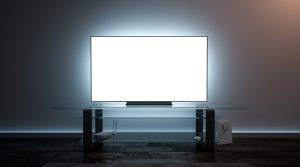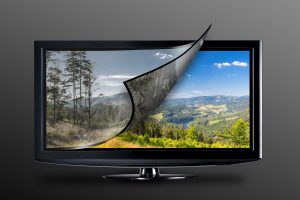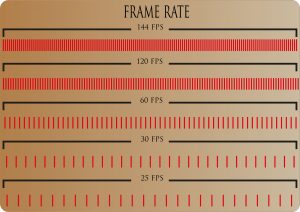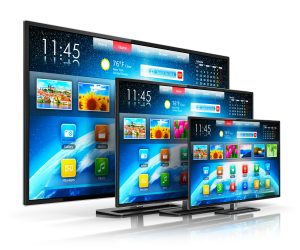OLED vs QLED; the epic clash between the two giants of the TVs. It won’t be an exaggeration to say that these two are the most deserving contenders for the the top-spot on the best TV list. Let’s check out how they are different, and which one is better than the other.
Technology

QLED: QLED is a regular LED TV, except it uses tiny nanoparticles called quantum dots to super-charge its brightness and color. That’s how it got its name Quantum Light Emitting Diode. It has a backlight made up of hundreds (or in some cases thousands) of LEDs.
An OLED means Organic Light emitting diode, but it has nothing to do with LED backlight surprisingly. In an OLED, every single individual pixel in an OLED set is a tiny LED light, one that is incredibly thin and can produce color and light in a single element. In simpler words, an OLED TV doesn’t need a backlight because every OLED pixel produces its own light.
Black levels and contrast

Contrast is basically the difference between the brightest and darkest parts of an image. So when it comes to black levels, OLED wins comprehensively thanks to its ability to go completely black when required. But A QLED is forced to dim its backlight to produce the near-perfect black levels that cause the light to spill over the black sections. This is called light-bleed. The bad thing is that it is quite visible.
Brightness

When it comes to brightness, QLED has an upper hand, thanks to its separate backlights. OLED on the other hand fails to even come close to the level of brightness that a QLED delivers. You won’t notice this in a darker room, but in a room that is well-lit with enough light coming through window panes, QLED TV provides better visibility.
Color space

OLEDs have always been at the top of the chart in terms of color accuracy, color brightness, and color volume. But since the introduction of Quantum Dot Technology, OLED got a tough competitor. Yet it’s pretty hard to dub any of these a clear winner. It’s safe to say that this round is shared.
Response time, input lag, and refresh rate

“Response time, lag, and refresh rate” are all the terms you must be familiar with if you are a gamer.
Needless to say, the lower the response time, the better the experience. The 2-8 milliseconds response time of a QLED sounds very good but is a no contest for an OLED’s response time of 0.1 milliseconds.
Levels of lag are very low for both the TVs, so it’s a tie.
Response time that signifies the number of times a TV refreshes its image in a second is also better in an OLED, slightly, but a win is a win, no matter how small the margin is.
Viewing angle

With QLED, the best view is at the dead center. The more you move away from the center, the picture quality takes a significant hit in terms of color, contrast, and brightness. But in an OLED, the picture remains intact, no matter how much you move sideways or even up or down. The quality of the image does not degrade at even drastic angles (up to 84 degrees). This is something that makes the viewing experience exceptional.
In simpler terms, an OLED gives the same picture quality to everyone in your family sitting in different places in the living room, whereas a QLED falters.
Size

An OLED has been sitting at a maximum size of 55 inches for years, in recent times we have seen 65 and 77-inch models as well, but a QLED is available in many big sizes nowadays. You can find 75,85, and even 98 inches big QLED TVs in the market.
Lifespan

Well, they’re both relatively new in the market. All we know is that in OLED, the organic material used takes a long time to degrade. Whereas, given the source of backlighting, a QLED also shows a promising long life. Rest assured, both the models will entertain you for years to come.
Screen burn-in

Screen burn-in can be simply explained as the phenomenon of an image leaving its shadow behind after exiting the screen. It is also known as image retention. It mostly happens with network logos at the corner of your TV screen. In OLED, the screen burn-in is visible, although not as problematic as it may sound, but yes, annoying at times.
QLED, on the other hand, absolutely guarantees a burn-in-free picture. And that is why QLED wins this round easily.
Power consumption

Thanks to the multiple super-bright backlights, QLED does not fare so well in terms of power consumption. It also emits more heat than an OLED does. OLED wins this one without a shadow of a doubt.
Eye comfort

The eye comfort regarding TV viewing totally depends on the levels of blue light emission from the screen. An OLED produces very little blue light as compared to that a QLED. That is why it delivers a more comfortable viewing.
Price

It all boils down to the price, doesn’t it? And when it does, a QLED wins it easily. The price difference is significant between the two TVs, and it gets even more drastic among the premium models.
Verdict
Both the TVs are backed by some really impressive technologies, and you can’t go wrong with any of these. QLED makes a strong case with its high brightness levels, longer lifespan, larger screens, and lower prices. But OLED with a better viewing angle, deeper black levels, and less power consumption while also being a better option for your health does put in a good fight.
So till the next-generation TVs kick in and beat both OLED and QLED, it would be safe to say that these two keep the top spot between themselves for a long time depending on, of course, what you want from a TV.


